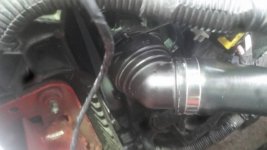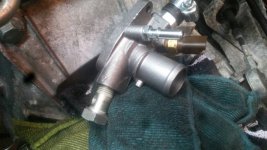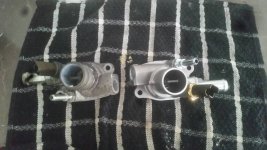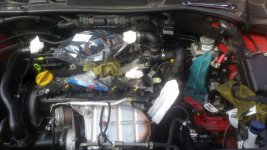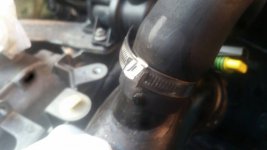I've been pretty busy for the last week, as some may have noticed, so I'm coming late to this thread. Thought I'd pitch in my ha'penny worth just in case some of it's useful. One wee word before we start - antifreeze is very poisonous stuff, DON'T POUR IT DOWN DRAINS. Collect it in a bucket, or whatever, stick it in a container and either dispose of it at your local recycling centre or probably your local garage will take it if you ask nicely.
There's probably more than one way to approach this task. If you don't want to get too "involved" and there seems to be no problems (ie. engine overheating or cool heater output when controls are set to hot) but do want to ensure reasonable protection for the engine by renewing most of the coolant then pulling the bottom hose - or undoing the rad drain plug/tap - and block drain if you have one, will drain most of the coolant on many vehicles. Removing the filler cap facilitates a rapid drain. (the Punto's bottom hose comes out the back of the water pump which is low down on the water jacket so you'll get a good drain) You will inevitably be left with some in the heater matrix and bottom of the engine water jacket but if your skill level/patience can't manage more than this if you replace the hose (new worm drive clip) and close/tighten any drain plugs/taps, then refill with a 50/50 antifreeze/water mix you won't go far wrong.
However if you want to ensure a more or less complete purge then you've got to flush and that's perhaps not as simple as some might imply. Firstly I'd pull the bottom hose (filler cap off). Drain plugs are often brittle or seized so I avoid them and I worry about damaging these "quick connect" type fittings so I like to just pull the hose off the stub. If your hose clamps are the crimped original fitting just destroy them and use worm drive (jubilee being one famous brand) hose clips on reassembly. - As has been mentioned by others. Now to the flushing. You need to flood plenty of water through the system to chase out contamination and deposits which might cause blockages and you need a good rate of flow. Simply sticking the garden hose into the filler on the expansion tank won't do much good on most engines because the hose from the expansion tank to the engine/radiator is quite small bore so you won't get much rate of flow. Ok, you might say, pop the top hose off the rad and stick the garden hose in it. Now there's a problem here because the engine is cold and the thermostat is going to be closed so you can't get any flow into the engine with the thermostat closed. What I like to do is to find where the heater supply pipe joins the engine. It's often on/near the thermostat housing or comes off the cylinder head somewhere as it needs hot water. On our petrol engined Punto and Panda 8 valves it's on the thermostat housing on the "back" (near side - passenger side) of the cylinder head. Take the hose off - a little fiddly but not that bad to do (you'll need another, smaller, hose clip on reassembly). Now stick the garden hose onto the thermostat stub from which you've just removed the heater hose and turn the water on. This connection takes water straight into the engine and is not impeded by the closed thermostat. Let it run, full bore, for a couple of minutes and you'll flush pretty much any rubbish and old coolant out of the engine. Now - turn the tap off, unless you need a shower? plug the hose into the heater hose and turn the water back on again. Water will flow through the heater matrix and back out of the return pipe - which on our engines connects into the metal pipe which runs along the front of the engine - then along the bottom hose and so out to your container. In my experience the heater matrix supply goes in at a low level and leaves to return at a higher level. So when you turn the water supply to the hose off and pull the garden hose out of the heater supply pipe the water will drain out of the heater matrix by gravity. On some cars you may have to manipulate the heater hose run so the water can drain "downhill". On modern cars you don't need to worry about heater control positions as the water flows unimpeded at all times through the matrix. If you think the matrix may be partially blocked pull the return pipe - on ours that's the one that goes into the metal pipe on the front of the engine - and back flush the heater matrix. Now you've flushed everything except the radiator itself. If you have no reason to suspect any flow problems with the radiator you can simply remove the top hose and flush copious quantities through with your hose. However if you suspect any thing is going on which might be impeding the flow you need to take the radiator out, turn it upside down and vigorously back flush it. After putting it all back together again, because you've had the hoses disconnected at all the "low points" there will be very little water left in the system. If you are really fanatical about removing water you can always jack up the side opposite where you've got a hose disconnected, before reassembly, to let it drain but I don't worry about this.
So now you've got everything reassembled and new hose clips tightened. I mix up 50/50 OAT antifreeze/deionised water in a 2 litre "pop" bottle. In fact our Scottish water is very soft and in days gone by I've used straight tap water - as does Jim up in the highlands - without any detrimental effects I'm aware of. Having flushed the whole system out you don't need to worry about mixing incompatible antifreezes (usually silicate - the "traditional" old type vs. Organic Acid Technology, OAT, which is mostly used now a days) I just buy whatever the local factor stocks - which for some time has been Tradetec. Both our Fiats are running with this and it seems just fine. People get very concerned because there might be a small amount of the flushing water left in the system to dilute your new coolant. You have to make a sensible assessment, by examining where the drain points on your system are, but I doubt if there is enough left in most applications to make a measurable difference.
As some of you may have seen when I posted about doing Becky's timing belt, I have a home made - very simple - piece of tubing which fits the expansion tank/filler neck and gives me about a foot or so (at a guess) of extra "head" when filling.
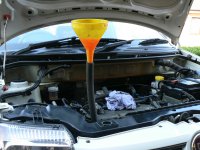

So with this "device" installed I open the bleed screws on radiator and heater top hose and merrily pour in the coolant. I find the extra head of pressure, small as it is, chases coolant through to the bleed nipples most satisfactorily. Once both bleeds have stopped emitting air they are closed off and the engine run. There will be trapped air which will circulate and drop the level in the expansion tank so you need to watch it carefully and top up as the engine warms through. A wee extra bleed of the heater hose may also be needed with the engine running to completely eliminate air in the heater circuit but I have had no problems with the heater circuit air locking when filling in this way.
Well, hope some of that was helpful? I wouldn't be surprised if my "pugglt" old brain has forgotten to mention something? feel free to comment anyone?
Regards
Jock
PS If coolant concentration is really "bugging" you then buy an antifreeze tester. Auto Express did a very good comparison review in July of this year which you can find on line.


